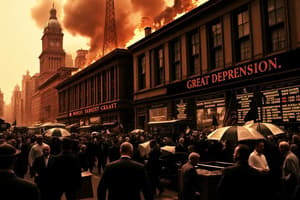Podcast
Questions and Answers
What led to a rise in unemployment in many industrialized nations during the Great Depression?
What led to a rise in unemployment in many industrialized nations during the Great Depression?
Companies producing large quantities of consumer goods could no longer find people to buy them, and prices for mass production consumer goods dropped worldwide
What event occurred in 1929 that marked the beginning of the Great Depression?
What event occurred in 1929 that marked the beginning of the Great Depression?
The New York Stock Exchange crash
Why did people initially invest heavily in the New York stock market?
Why did people initially invest heavily in the New York stock market?
Because shares could be bought on credit and sold for a profit when prices rose
What happened when shareholders lost confidence in the market and sold their shares?
What happened when shareholders lost confidence in the market and sold their shares?
How did workers' reduced purchasing power contribute to the Great Depression?
How did workers' reduced purchasing power contribute to the Great Depression?
What was the result of the government's inability to address the economic downturn during the Great Depression?
What was the result of the government's inability to address the economic downturn during the Great Depression?
What was the global impact of the American economy's collapse during the Great Depression?
What was the global impact of the American economy's collapse during the Great Depression?
What was the living situation like for many people during the Great Depression?
What was the living situation like for many people during the Great Depression?
What was the impact of the Great Depression on women and children?
What was the impact of the Great Depression on women and children?
What was the effect of unemployment on soldiers who had returned from fighting?
What was the effect of unemployment on soldiers who had returned from fighting?
What form did government relief take during the Great Depression?
What form did government relief take during the Great Depression?
Who was eligible for sustenance payments during the Great Depression?
Who was eligible for sustenance payments during the Great Depression?
What kind of compromises did people make to survive during the Great Depression?
What kind of compromises did people make to survive during the Great Depression?
Flashcards are hidden until you start studying
Study Notes
The Great Depression
- Global economic downturn in the 1930s characterized by severe hardship and high unemployment
- Triggered by the 1929 New York Stock Exchange crash, which led to a sharp decline in consumer spending and industrial production
Causes of the Great Depression
- Overproduction of consumer goods led to a surplus, causing prices to drop worldwide
- Unemployment rose in many industrialized nations as companies struggled to find buyers for their products
The Stock Market Crash of 1929
- Share prices inflated to unreasonable highs due to speculative buying on credit
- When confidence in the market decreased, share prices rapidly fell, causing the market to crash
- Stockbrokers, investors, and business owners lost significant amounts of money, leading to widespread financial ruin
Consequences of the Great Depression
- Workers experienced job losses, wage cuts, and reduced purchasing power, leading to further decreased production and employment
- Poverty spread rapidly as governments struggled to respond effectively to the crisis
Australia and the Great Depression
- The Great Depression started in America and had a ripple effect on other countries, including Australia, due to the network of borrowing and loan repayments from the war.
- Germany was severely affected by the Great Depression, partly due to its ongoing repayment of war reparations.
- In the 1930s, Australia's economy was heavily dependent on international trade, which collapsed when the American economy failed, resulting in 2/3 of global trade coming to a halt.
- The economic crisis led to widespread unemployment, causing many people to lose their homes and live in substandard housing, known as shanty towns, built from discarded materials on waste ground.
- Women and children became the primary breadwinners, as they were cheaper to employ, leading to a shift in family dynamics.
- Returning soldiers, still recovering from traumas, struggled to find work, leading to family breakdowns and a rapid increase in suicide rates.
The Susso
- The Australian government provided relief to the unemployed in the form of sustenance payments, known as the "Susso".
- To be eligible, individuals had to be unemployed for a sustained period, have no assets or savings, and be truly destitute.
- The sustenance payments were given in the form of rations or coupons, forcing people to make humiliating compromises to survive.
- The crisis led to a proliferation of shabby and desperate measures to get by, with people resorting to tricks and expediences to make ends meet.
Studying That Suits You
Use AI to generate personalized quizzes and flashcards to suit your learning preferences.




